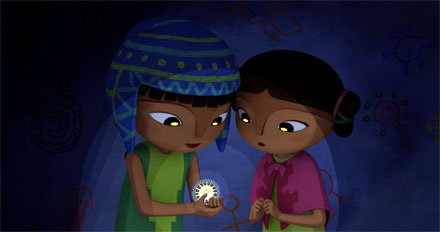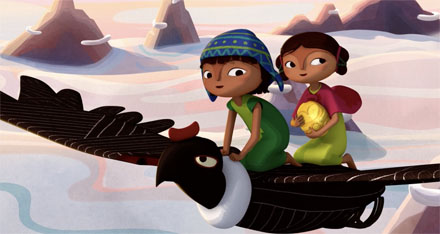
With the June 7 release of 2019 Cesar Award nominee Pachamama, followed by its first global original animated feature, Klaus coming this holiday season, Netflix is clearly establishing itself as a player in the world of film animation. Pachamama, an action-adventure with a strong ecological message, is from writer-director Juan Antin (Mercado the Martian) and producer Didier Brunner (The Triplets of Belleville, The Secret of Kells, Ernest and Celestine).
Jackson Murphy: Pachamama took 14 years to make. That’s incredible. What happened 14 years ago that really got the ball rolling?
Juan Antin: Actually, I started thinking about Pachamama after releasing my first film, Mercado the Martian in 2002. And then after finishing that film, I started thinking of Pachamama. I had to travel a lot to do some research. I was living in Argentina at the time. I traveled to the north of Argentina where the stature of Pachamama is very vivid – and then to Peru and then to Bolivia. A lot of research was getting into the idea of how these indigenous people think about Pachamama. I wanted to make this film an homage to them, and make it from the point of view of them: their vision on the conquest… and the earth and Pachamama.
The first years were mostly traveling and thinking and writing the scripts, meeting shamans and chiefs of communities and doing research. Why it took so long is because at first I wanted to make a stop-motion film. So I started a production in Argentina as a stop-motion film. I event shot a trailer because I wanted the film to be full of light textures and materials: gold and clay. That’s why I thought of stop-motion.
And then it was quite difficult to build a production around a stop-motion film at that time. And in Argentina, there was a huge economic crisis, too. So it wasn’t the right moment. And then I met a French producer, and he proposed me to do a French co-production. So I moved to France with my family, and then I re-started production here. It look us a long time to get the financing, especially because “Pachamama” is quite unusual in its look and its approach. So that scared many producers.
We knocked on the right door and we got the producer, Didier Brunner, who is the producer of many very good films like “The Triplets of Belleville”. He loves auteur films and he… read the script and said it is good. But it took many years of knocking on doors and getting production that started and stopped. It was… very intense. But finally it’s done! It’s complete! (laughs)

JM: You talk about how the look is very unique – it’s so bright and yet mystifying. It’s got an interesting blend with the CG and the hand-drawn mixing. It almost often looks like a picture book. Were you going for that sort of look?
JA: Yeah. I think the special look comes from… stop-motion. We’ve made puppets in clay and puppets for animation. All this development in stop-motion gave a special look to the 3D. Finally I accepted to do the film in 3D. At first I was unsure. But then after the first test we made, I was convinced because I managed to give that special look (materials, earthy, clay look). That’s why the look is very different. It’s a 3D film but conceived as a stop-motion film. And also in animation, I briefed the animators on animating with very little interpolations – not very fluid-like animations like 3D computer animation. The backgrounds are 2D. They are hand-painted. In the end, I do think it’s a picture book look. You’re right.
JM: And the shapes of these characters… I noticed that the villagers are kind of round. The Incas are more angular. And the Spanish invaders are very pointy. Were you intentional when it comes to how these three different groups of people look?
JA: Yeah. The idea was that each group of people in the film was representative in their own. So the idea of the villagers, they were representing Colombian pottery: vases if they were coming alive and speaking. I always found that those pottery and ceramics, they are real characters… those faces. I wanted to base all the characters’ designs on this original basis – very Colombian.
The Incas… are an empire. The idea was to make them square and look like buildings. And we based the Inca design on Inca architecture. So they look like the city of Cuzco. They look like temples. And for the Spanish characters, we based them mostly on Renaissance art. It was a little more angular – a little more rich in details – and a little more realistic too on the proportions of characters.
JM: And when it comes to this script: there are lighter, fun elements with Tepulpai and Naira, but also serious themes about violence and death. How difficult was it to blend those two themes together to create an effective story?
JA: One of the most difficult things was to [depict] the violence and the death. The conquest of America is a violent story. And we wanted a film for children – for small children, from 4 or 5 years old. So all the violence in the film is symbolic. It’s not real. You don’t see violence at all. Adults know and can interpret some things: for example, in the battle, the sky turns red. And in Cuzco, you see red blood flowing in the river. But you don’t see the violence.
Leaving the violence out of camera – and there are screams – but it’s not shocking for small children. It was one of the most difficult things to do. There were some sequences that were even animated, and then we had to take them out because they were too much.
But for me, as you said, “Pachamama” has a lot of different themes. The main theme is ecology, in a way – and speaking about love and respect to Earth. I thought that it’s very important to talk to small children.
JM: And the violence is understood. It doesn’t have to be seen for people to get what’s going on. That makes sense.
JA: It’s a way to make it fun and with jokes. Every time something’s a little difficult, there’s a little joke that arrives to get out that anguish from children.
JM: Sure. There’s a very nice line that Tepulpai says early on in the movie – that you can dream while you’re awake so that you can dream the dream you want. Does that line have any special significance for you?
JA: No – I think it was to portray the character. He’s a dreamer. He’s speaking with Naira, who’s kind of the opposite [of him]. She’s very concrete. He doesn’t understand. I like the dialogue very much. It helps know the characters. It’s a mirror of the characters to get into them.

JM: The Great Condor is a symbol throughout this film. Is there or has there ever been a Great Condor in your life?
JA: Yeah, absolutely. I also in my travels… I believe I represent the Condor. (laughs) I love that animal. There are so many animals in the film that come from the Colombian and Indian cultures, like the Condor, the llama, the snakes. But I love the Condor.
JM: It’s a beautiful creature. And “Pachamama” was nominated for the Best Animated Film honor at the Cesar Awards, the French version of the Oscars, earlier this year. Did you go to the Cesar Awards?
JA: Yes! I went there. It was really fun. It was really cool – a great experience.
JM: How would you say it differs from the Academy Awards? Is there a certain style the French do with their awards show?
JA: No. Between us – I think it’s a copy of the Oscars. (laughs) They make jokes. It’s something they started to do in the Oscars style. There’s a presenter. He makes jokes. It’s the same format.
JM: But it must’ve been amazing for you to be nominated and to be there representing this film that you’ve worked so hard on.
JA: Yeah. Absolutely. After so many years of work… absolutely incredible.
JM: And right around the time of getting the nomination, Netflix acquired the movie and will stream it on June 7th. What do you hope the worldwide Netflix audience takes away from watching “Pachamama”?
JA: I’m thrilled about the idea that so many people will be able to… watch “Pachamama” on Netflix. I’m aware that it’s 183 countries with 19 languages. It’s amazing for a filmmaker to have that possibility of reaching an audience that size. The thing I want the audience to get from “Pachamama” is the same thing that moved me from the very first research and work I did in the north of Argentina and Bolivia. And it’s… feeling the emotions of love and respect to the Earth.
You can think about ecology, and there’s a lot of intellectual stuff going on – explaining to children the climate. But all that is intellectual stuff, and children don’t get it really, you know? It’s more powerful and one of the things I wanted to do with “Pachamama” was to go to the emotion – go to the heart and explaining things, not in a very intellectual way, but in an intuitive way – and with emotions with colors. Very simple ways. That’s what I want people to get – for children to be moved about how these people love Pachamama and Mother Earth.
- INTERVIEW: The Spirit Of “The King Of Kings” - March 31, 2025
- INTERVIEW: Ready… Set… “RoboGobo” - March 24, 2025
- INTERVIEW: Building “BE@RBRICK” - March 17, 2025


 May 31st, 2019
May 31st, 2019  Jackson Murphy
Jackson Murphy  Posted in
Posted in  Tags:
Tags: 






